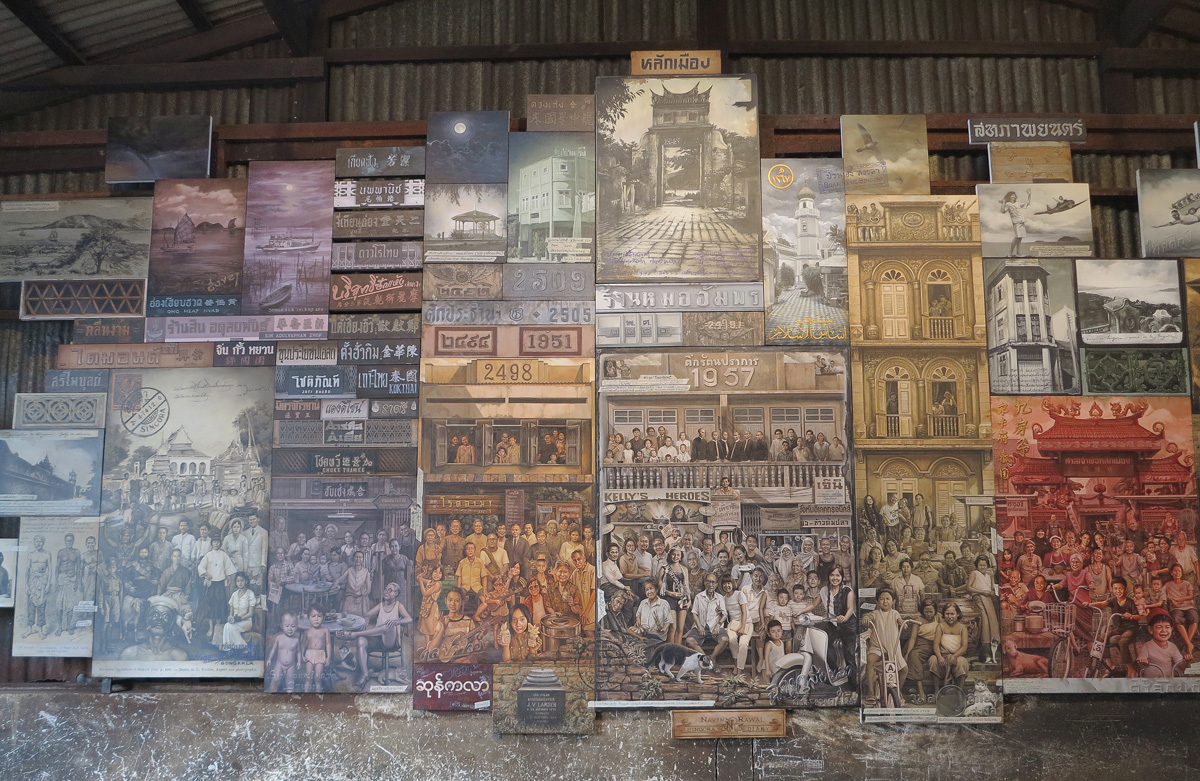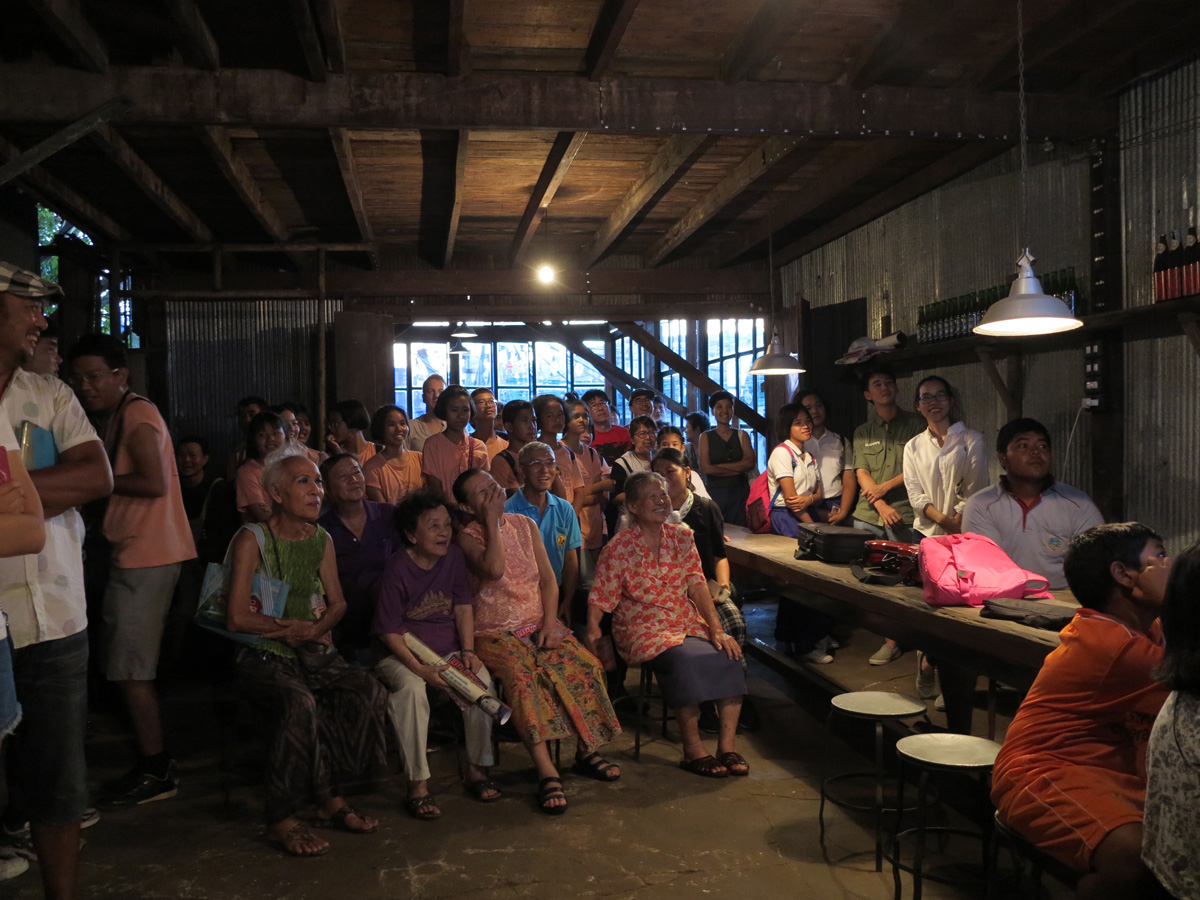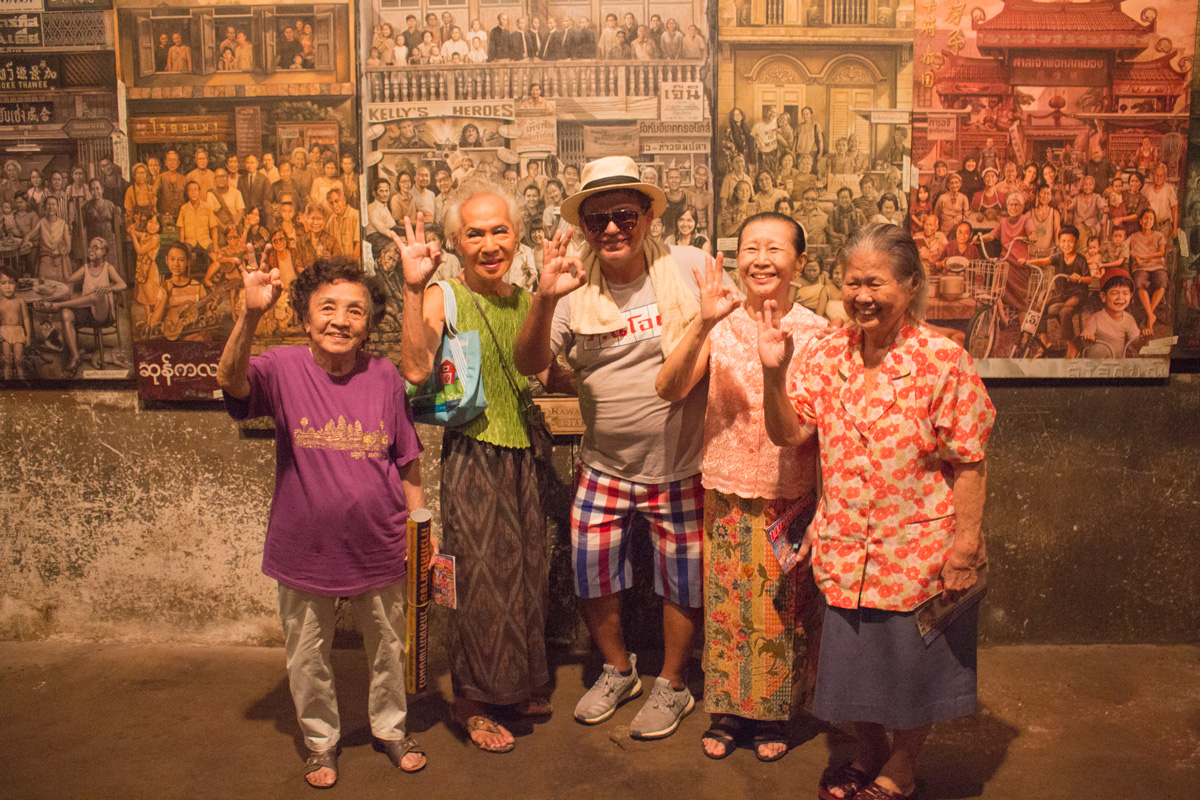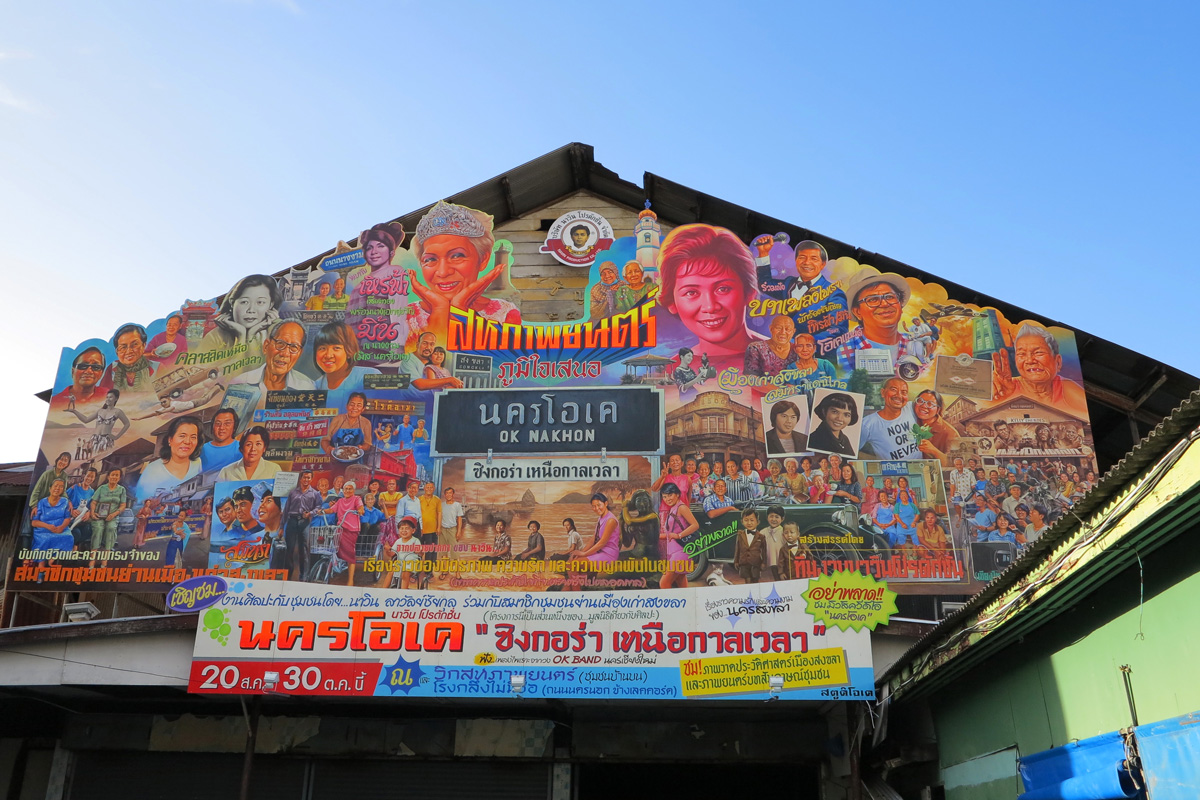THIS TIME, NAVIN RAWANCHAIKUL HEADS SOUTH BUT HE STILL AIMS TO USE HIS ART AS A BRIDGE TO BRING THE COMMUNITY TOGETHER OK PEOPLE
If consistency were to be used as a judging criterion, Navin Rawanchaikul, without a doubt, would be considered one of the most hard-working Thai artists of contemporary times with the continual development in his body of work throughout the past several years being an excellent source of proof. Last year, for example, after the opening of the 20th anniversary exhibition of Navin Production in three different locations in Chiang Mai, the artist brought ‘The School of Akakura’ (2015) to be featured at the 6th Echigo-Tsumari Art Triennale before returning to Japan this year for the creation of ‘OK Tower’ on Megijima Island as a part of the Setouchi Triennale 2016. It is also within this same period of time that Rawanchaikul and his team from Navin Production split their time to travel back and forth to Songkhla for the research of ‘OK Nakorn – Singora Diary,’ his exhibition we are about to tell you about in this article.
What’s so special about ‘OK Nakorn – Singora Diary’ is probably the fact that while most of Rawanchaikul’s community-driven works find themselves set in places that are highly related to his own ethnicity, origin or birthplace, be it the Kad Luang (Waroros Market) in Chiang Mai, the city that is not only his hometown but also the place where his immigrant ancestors of Indian descent settled down and started a textile business known to the locals as the ‘OK shop,’ or Japan where Rawanchaikul spends half his time living with his wife and daughter. For Songkla, a province in southern Thailand that he has no connection with whatsoever, Rawanchaikul sees the common characteristics it shares with the Kad Laung as it is also a community market that is home to people from different ethnicities and cultures. With a great amount of culturally valuable old buildings being bought and commercialized by investors with big money, Rawanchaikul’s realization that the story of this old community could one day disappear motivated him to begin his ‘documentation.’ He returned to Songkla with a team of staff that helped him to photograph the community as they interviewed and talked with the locals.

Similar to his previous works such as ‘Mahakad’ (2010) and ‘A Tale of Two Homes’ (2015), for ‘OK Nakorn – Singora Diary,’ Rawanchaikul’s documentation of the community’s narratives is conveyed through the use of media he is familiar with, such as the 15-meter-painting, ‘OK Nakorn’ (OK City) that brings together the stories of many people in the community in the form of movie characters and uses the technique of a hand-painted cutout billboard that is fading away from people’s memories. The work is being installed at the front of Saha Cinema (known to the locals as Saha Phapayon—a stand-alone cinema built in 1930) and is somewhat of a resurrection of the deserted establishment through the community’s very own history. The work is one of Rawanchaikul’s most beautiful paintings, partly perhaps due to the fact that it is located on a site that is meaningful to its presence. Another painting is a community portrait called ‘Singora Diary,’ where Navin Production gathered photographs of community members, local buildings and narratives from past to present for the creation of over 70 paintings. This series of works are shown at an unnamed machine shop on Nakorn Nok Road, a venue that also exhibits two video installation pieces. The first video features interviews with locals from different occupations and cultural backgrounds while the other shows an “OK Nakorn” music video where Rawanchaikul has performed with the OK Band in the form of a continual collaboration since the 20th anniversary exhibition of Navin Production.

It is not just the artistic style that is similar, for this project Rawanchaikul came across the same problems he once encountered working under this type of project, from informing community members about the purpose of his work and its aims to documenting and reflecting the stories of the community rather than generating any profit, and furthermore receiving insufficient support from the bureaucracies. Nonetheless, after the works were completed, we can see what has always been present at Rawanchaikul’s exhibitions—local people showing up with smiles on their faces as we hear laughter and engaging conversations, recollections of past memories and discussions about the present. Once again, Rawanchaikul’s art humbly places itself before the eyes of the local people and while its audience’s knowledge in art may be far from expert, the work not only communicates with the viewers but is also acknowledged, understood and appreciated. This is not the first time that Rawanchaikul’s artistic creation has found a way to bring people together. What has been created is a more perceivable connection within the community, now seen and realized for its importance.

‘OK Nakorn – Singora Diary’ is a part of Songkhla [Here and Now] by Klaomard Yipintsoi and Nopadon Kaosam-ang, founders of About Art Foundation whose AARA- Project Songkhla aims to stimulate awareness of the value of architectural preservation in the area. Along with Rawanchaikul’s exhibition, which is being held from the 20th of August to the 30th of October 2015 (opening hours 13.00-18.00, only on weekends and public holidays), About Art Foundation and AARA has also launched its new art space, MISIEM’S , and four other preserved buildings in Songkla old town that are now open for public access. Showcased at each site are drawings of the architecture by Assistant Professor Sudjit (Svetachinda) Sananwai and students from the Faculty of Architecture, Rangsit University and Banana Studio. Visiting the site, viewers are provided information about the architecture by students from the Faculty of Architecture, Rajamangala University of Technology Srivijaya. Being a part of Here and Now Project Songkhla, through the narratives of the community and its people, Rawanchaikul has brought a new light to the city and its magnificent architecture.
Rawanchaikul and the staff have now become Songkhla’s homeboys. The folks from OK Nakorn are now familiar faces adored by the locals and never allowed to pay for anything when they go into the local shops.

ถ้าวัดกันที่ความถี่ของผลงานที่ปรากฏออกมาให้เห็นแล้ว ไม่ต้องสงสัยเลยว่า นาวิน ลาวัลย์ชัยกุล คือศิลปินไทยอีกคนหนึ่งที่ทำางานหนักอย่างต่อเนื่องมาตลอดหลายปีที่ผ่านมา อย่างในปีที่แล้วเป็นต้น หลังจากเปิดนิทรรศการเฉลิมฉลองครบรอบ 20 ปี ของ นาวินโปรดักชั่น อย่างยิ่งใหญ่ไปยัง 3 โลเคชั่น ในเชียงใหม่ นาวินก็นำาผลงาน ‘The School of Akakura’ (2015) ไปร่วมจัดแสดงใน 6th Echigo-Tsumari Art Triennale ก่อนจะกลับไปญี่ปุ่นอีกครั้งในปีนี้เพื่อสร้าง ‘OK Tower’ บนเกาะ Megijima ใน Setouchi Triennale 2016 และในช่วงเวลาเดียวกันนั้นเอง นาวินและทีมงานนาวินโปรดักชั่นก็ยังแบ่งเวลาเดินทางไปสงขลาอยู่หลายรอบเพื่อรีเสิร์ชข้อมูลสำหรับ ‘OK Nakorn – Singora Diary’ นิทรรศการล่าสุดของเขาที่เรากำาลังจะพูดถึงในบทความนี้
ความพิเศษ ของ ‘OK Nakorn – Singora Diary’ คงจะเป็นว่า ในขณะที่ที่ผ่านมาส่วนมากศิลปะในชุมชนของนาวินมันเลือกไปอยู่ในสถานที่ที่เกี่ยวข้องกับชาติพันธุ์และถิ่นกำเนิดที่อยู่อาศัยของเขา เช่น ชุมชนกาดหลวง (ตลาดวโรรส) ในเชียงใหม่ ที่ที่ต้นตระกูลของเขาอพยพโยกย้ายถิ่นฐานจากอินเดียมาตั้งรกรากและเปิดกิจการขายผ้า “ร้านโอเค” และเมืองที่เขาเกิดและเติบโต รวมไปถึงญี่ปุ่น – ประเทศที่นาวินแบ่งเวลาอีกครึ่งหนึ่งอาศัยอยู่กับภรรยาและลูกสาว แต่สำหรับสงขลาแล้ว นาวินไม่มีความเกี่ยวข้องใดๆ กับเมืองนี้เลย นอกจากเมื่อเขาได้เดินทางผ่านไปและเห็นว่าเมืองเก่าสงขลาเหมือนกับชุมชนกาดหลวงอยู่อย่างนึงคือ ความเป็นชุมชนค้าขายที่มีผู้อยู่อาศัยผสมผสานกันหลากหลายเชื้อชาติและวัฒนธรรม และนับวันอาคารเก่าที่มีคุณค่าจำนวนมากก็ยิ่งจะถูกกลุ่มนายทุนกว้านซื้อไปลงทุนธุรกิจ เมื่อตระหนักได้ว่าเรื่องราวของชุมชนเก่าแก่แห่งนี้อาจเลือนหายไปในวันหนึ่ง เขาจึงต้องการ “บันทึก” ดังนั้นนาวินจึงกลับมาสงขลาอีกครั้งคราวนี้เขามาพร้อมกับทีมงานกลุ่มใหญ่เพื่อตระเวนถ่ายภาพอาคารบ้านเรือนและสัมภาษณ์พูดคุยกับชาวชุมชน
คล้ายกับผลงานชิ้นก่อนๆ เช่น ‘Mahakad’ (2010) และ ‘A Tale of Two Homes’ (2015) เป็นต้น ใน ‘OK Nakorn – Singora Diary’ นาวินยังคงเลือกถ่ายทอดการบันทึกเรื่องราวของชุมชนออกมาในรูปแบบของสื่อเดิมๆ ที่เขาถนัด ตั้งแต่จิตรกรรมขนาดใหญ่ขนาด 15 เมตร ‘นครโอเค – ซิงกอร่าเหนือกาลเวลา’ หรือ ‘OK Nakorn’ (OK City) ที่นำเอาเรื่องราวของผู้คนในชุมชนมารวบรวมคล้ายตัวละครหลากหลายในภาพยนตร์ และใช้เทคนิคการเขียนภาพคัทเอาท์โฆษณาภาพยนตร์ที่กำาลังค่อยๆ สูญหายไปจากบ้านเราผลงานชิ้นนี้ติดตั้งอยู่ด้านหน้าของวิกสหภาพยนตร์ (โรงภาพยนตร์เก่าที่ปิดบริการไปแล้ว) คล้ายกับการชุบชีวิตโรงหนังเก่าให้คืนมาอีกครั้งด้วยเรื่องราวของชาวชุมชนเอง และนับเป็นจิตรกรรมที่สวยที่สุดอีกชิ้นของนาวิน ส่วนหนึ่งคงเพราะมันได้เข้าไปอยู่ใน siteที่มีความหมายในตัวของมันเอง ส่วนจิตรกรรมอีกชิ้นคือ community portrait ‘Singora Diary’ ที่ทางนาวินโปรดักชั่นรวบรวมภาพชาวชุมชน อาคารบ้านเรือน และเรื่องราวต่างๆ จากทั้งในปัจจุบันและอดีตมาวาดเป็นจิตรกรรมกว่า 70 ชิ้น จิตรกรรมชุดนี้จัดแสดงอยู่ที่โรงกลึงไม่มีชื่อ ถนนนครนอก โดยภายในพื้นที่จัดแสดงยังมีสื่อวิดีโออีกสองชิ้นคือ วิดีโอสัมภาษณ์ชาวชุมชนจากหลากหลายอาชีพและเชื้อชาติ และมิวสิควิดีโอเพลง ‘นครโอเค’ สื่ออีกรูปแบบหนึ่งที่นาวินยังคงทำงานร่วมกับโอเคแบนด์ ต่อเนื่องมาจากนิทรรศการครบรอบ 20 ปี นาวินโปรดักชั่น
ไม่ใช่แค่รูปแบบผลงานศิลปะเท่านั้นที่คุ้นเคย แต่ในการทำงานครั้งนี้ นาวินยังคงต้องพบเจอกับปัญหาเดิมๆ อยู่เช่นเคย ไม่ว่าจะเป็น การทำความเข้าใจกับชาวชุมชนว่าสิ่งที่เขาทำคืองานศิลปะที่ต้องการบันทึกและสะท้อนเรื่องราวของชุมชน ไม่ใช่หาผลประโยชน์แบบนายทุน หรือ การสนับสนุนจากทางราชการที่อาจไม่ค่อยเพียงพอเท่าไรนัก แต่แล้วเมื่อผลงานทั้งหมดสำเร็จออกมา ภาพที่เรามักได้เห็นในนิทรรศการของนาวินก็ปรากฏขึ้นอีกครั้ง นั่นคือภาพของชาวชุมชนที่เดินทางมาดูผลงานแต่ละชิ้นด้วยใบหน้ายิ้มแย้ม และภายในพื้นที่จัดแสดงงานก็เต็มไปด้วยเสียงหัวเราะและบทสนทนาอย่างออกรสออกชาติถึงเรื่องราวต่างๆ ทั้งในอดีตและปัจจุบัน นี่จึงเป็นอีกครั้งที่ศิลปะของนาวินเอาตัวเองมาวางลงอย่างนอบน้อมให้ชาวบ้านร้านตลาดที่อาจไม่เคยมีความรู้เกี่ยวกับศิลปะใดๆ เลย สามารถรับรู้และชื่นชมได้ และก็เป็นอีกครั้งที่การทำางานศิลปะของเขาได้เชื่อมโยงผู้คนเข้าด้วยกันจนสร้างบรรยากาศของชุมชนให้แจ่มชัดและเน้นย้ำให้เห็นความสำคัญมากยิ่งขึ้น
‘OK Nakorn – Singora Diary’ เป็นส่วนหนึ่งของ Songkhla [Here and Now] โดย เกล้ามาศ ยิบอินซอย และ นพดล ขาวสำอางค์ จาก About Art Foundation – AARA Project Songkhla ที่ต้องการปลุกจิตสำนึกเกี่ยวกับการอนุรักษ์อาคารเก่าในสงขลาโดยพร้อมๆ กับการจัดแสดงนิทรรศการของนาวินในระหว่างวันที่ 20 สิงหาคม – 30 ตุลาคม 2559 (เปิดเฉพาะเสาร์ อาทิตย์ และวันหยุดนักขัตฤกษ์ 13.00-18.00) ทาง About Art Foundation และ AARA ก็ยังเปิดพิพิธภัณฑ์ MISIEM’S และอาคารเก่าในบริเวณเมืองเก่าสงขลาอีก 4 แห่ง เพื่อให้ผู้ชมทั่วไปได้เข้าไปชม โดยแต่ละแห่งจะมีภาพวาดบันทึกสภาพของสถาปัตยกรรมนั้นๆ โดย ผศ. สุดจิต (เศวตจินดา) สนั่นไหว และ นักศึกษาคณะสถาปัตยกรรมศาสตร์ มหาวิทยาลัยรังสิต ร่วมกับ บานาน่า สตูดิโอ จัดแสดงประกอบ และในอาคารแต่ละหลังยังมีนักศึกษาจากคณะสถาปัตยกรรมศาสตร์ มหาวิทยาลัยเทคโนโลยีราชมงคลศรีวิชัย คอยให้ข้อมูลความรู้เกี่ยวกับสถาปัตยกรรมอีกด้วย การเข้ามามีส่วนร่วมใน Here and Now Project Songkhla ครั้งนี้ของนาวินจึงเหมือนการนำาเอาเรื่องราวของชาวชุมชนมาเติมเต็มให้กับเมืองและสถาปัตยกรรมเก่าแก่ให้กลายเป็นเมืองที่มีชีวิตขึ้นมาอย่างสมบูรณ์
ส่วนตัวนาวินเองและทีมงานของเขาก็ได้กลายเป็นเสมือนลูกหลานของชาวสงขลาไปเรียบร้อยโรงเรียนโอเค เรียกว่าเดินเข้าออกร้านไหน แทบจะไม่มีใครยอมให้พวกเขาควักกระเป๋าจ่ายสตางค์เลย
TEXT & PHOTO: TUNYAPORN HONGTONG
navinproduction.com

